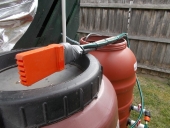posted 11 years ago
While I don't consider myself an expert, I do have a few years experience with a 2000 gallon aquaponic system. This was a small non-commercial AP system that didn't require expensive equipment such as food mixing tanks and a pellet mill. I think it is important to understand that AP systems are not natural (although they mimic some functions of a natural system). When you place animals in such a system, the expectation is that you will need to provide everything they require to live: trace minerals, food, water oxygenation, PH balance, etc. Very few things in life can be accurately described with absolutes, such as the "need" to buy feed. If you want to get optimal results, you will likely want to provide some amount of commercial feed. not everyone is after optimal results though. A natural (non commercial) diet is fine as long as the animals are growing and well cared for.
I suspect most people opt for commercial feed because it is easy, convenient, and it provides a complete diet. Trying to regularly provide a balanced diet from other sources can become difficult and/or time consuming. It is a viable option if you have more time than money or strong beliefs about commercial feed (contents or how it is sourced). I advocate using as much locally sourced feed as possible, but i am also a realist. There will be days when you cant go dig worms and forage (such as sickness, family emergency, vacation). If someone else has to fill in for you, it is likely that they will be unaccustomed to digging worms or uncomfortable handling BSF maggots. It is wise to have a bag of commercial feed on hand for such times.
We grew duckweed that provided about half of the food required and supplemented it with bag feed, black soldier fly, worms, and offerings from the bug zapper. My method was to feed duckweed and commercial feed at the same time and carefully observe which the fish ate first and how long it took them to finish off the commercial feed (ideally no more than 5 minutes). If the fish ate the pellet food first and ignored the duckweed, i assumed they needed something that they were not getting elsewhere and adjusted the ratio. Leftover duckweed on the top of the water isn't bad, but overfeeding pelleted food can lead to serious problems.
I would also like to share a source of fish feed that I have not seen mentioned elsewhere. We had a bumper crop of acorns this year and I gathered them to reforest a few acres on the back of our property. I dumped them out on a table to sort the ones that were wormy. I put a mesh window screen down to keep them on the table and make moving them around easier. By the time i finished sorting, i noticed 30-40 small white grubs had crawled out onto the screen. they died a swift death in the jaws of our hungry fish. I left the wormy acorns out overnight and had 50-60 more grubs the following day. I would roll the acorns around on the screen daily, and come back a few minutes later to collect the grubs. this provided some easily obtained supplemental feed in the fall (around the time the duckweed growth slowed down).







